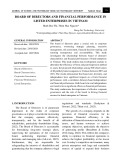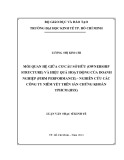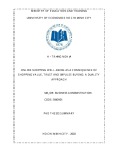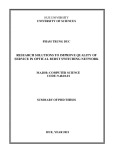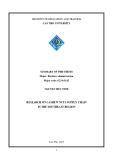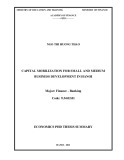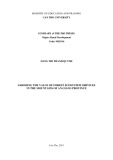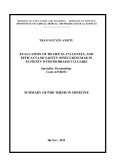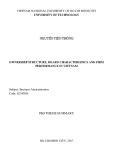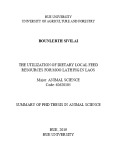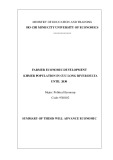VIETNAM NATIONAL UNIVERSITY OF HO CHI MINH CITY UNIVERSITY OF TECHNOLOGY NGUYỄN TIẾN THÔNG OWNERSHIP STRUCTURE, BOARD CHARACTERISTICS AND FIRM PERFORMANCE IN VIETNAM
Subject: Business Administration Code: 62340501
PhD THESIS SUMMARY
HO CHI MINH CITY, 2017
The Thesis was completed in University of Technology –VNUHCM Advisor 1: Dr. Nguyễn Thu Hiền Advisor 2: Assoc Prof.Dr. Piman Limpaphayom Independent examiner 1: Assoc Prof.Dr. Vương Đức Hoàng Quân Independent examiner 2: Assoc Prof.Dr. Đỗ Bá Khang Examiner 1: Assoc Prof.Dr. Võ Thị Quý Examiner 2: Assoc Prof.Dr. Nguyễn Minh Hà Examiner 3: Assoc Prof.Dr. Nguyễn Minh Kiều The thesis will be defended before thesis committee at ................................................................................................................................ ................................................................................................................................ on The thesis information can be looked at following libraries:
- General Science Library Tp. HCM - Library of University of Technology – VNU-HCM
LIST OF PUBLICATIONS
1. Nguyen, T. T. (2014). Factors influencing Voluntary Disclosure of Vietnamese listed companies. EBES, Singapore, ISBN: 987-605-64002-7-8 2. Nguyen, T. T. (2015). Internal Governance Mechanisms and Firm Performance: The Case of Vietnam. ICBMLS, Singapore, ISSN 2454-5899 3. Nguyen, T. T. (2015). Internal Governance Mechanisms and Firm Performance: The Case of Vietnam. PEOPLE: International Journal of Social Sciences, Special Issue, 254-269. 4. Nguyen, T. D., Nguyen, H. T. and Nguyen, T. T. (2013). Role of Dividend Policy to Shareholders Value and Risk in Condition of Disclosure & Transparency. IFMA, Indonesia, ISBN: 987-602-14716-0-9. 5. Nguyen, H. T., Tran, T. D., Nguyen, H. N. H., Vo, N. T.T. and Nguyen, T. T. (2016). Quản Trị Công Ty và Quá Trình Điều Chỉnh Động Cấu Trúc Vốn – Quan Sát Từ Các Doanh Nghiệp Niêm Yết Trên Thị Trường Chứng Khoán Việt Nam. Tạp Chí Khoa Học Đại học Mở TP.HCM, 50 (5), 25-40.
ABSTRACT
Ownership structure is crucial to corporate governance as it explains sources of agency conflicts. Roles and impacts of different corporate owners on corporate performance and governance have been studied worldwide, except for the role of State-Owned Holding Company (SOHC). This study examines the role of SOHC in the management and governance of listed companies with State capital in Vietnam, in comparisons with other owners in general government linked companies (GLCs) and non-government linked companies (non-GLCs). The result shows that SOHC-linked companies (SLCs) deliver superior returns and enjoy higher valuations than GLCs and non-GLCs as a result of higher profitability, and lower leverage ratio. The evidence shows that when SOHC hold a dominant ownership, it exercises positive control on firms, which results in better market performance. Further analysis shows that SLCs hold more cash and the shareholders appreciate the cash hold by the SLCs, robust to the firms’ characteristics. Without evidence that SLCs have special privileges and lower business risks, the better shareholder value of cash in SLCs is revealed to come from better corporate governance. This study contributes to the literature of ownership structure and corporate governance and provides an evidence for SOHC as a positive ownership and monitoring mechanism in improving corporate governance and firm performance in companies with State-owned capital in Vietnam. The study also looks at the impacts of other owners in listed companies, family ownership, foreign ownership, and board characteristics, board independence on firm performance and yields evidence for various impacts of internal governance mechanisms on firm performance.
CHAPTER 1 INTRODUCTION
1.1 Overview
The separation between ownership and control in companies creates a better
way to raise capitals from society to expand business operations but on the
other hand creates conflicts of interests between shareholders and agents. The
initiatives to minimize these conflicts formed corporate governance framework
in different countries. The principles of corporate governance were introduced
by OECD in 2004 with a purpose to support governments in assessing and
completing the legal framework and institutional environments for effective
operating environments while providing the guidelines for the stock markets,
investors and stakeholders involved into management activities.
In transition economies like Vietnam, corporate governance concept is not only
new for local companies but also hazed for government, investors and
stakeholders. Corporate governance principles have not been applicable for
listed companies until 2007. As a result, it is necessary to study impacts of
corporate governance aspects on firm performance in which ownership is an
objective for this study. The findings would contribute both to theoretical
understanding of corporate governance and practical implications for regulatory
enhancement.
State-owned enterprises (SOEs) have dominant role in Vietnam as a result of
the replication of Soviet Union model in 1950s. The policy of executing SOEs
with five-year plans was a failure without any evident achievement causing
economy recession in 1980s and lead to economy renovation named “Đổi mới”
starting in 1986 (Vu, 2002; Vu, 2003; Nguyen et al., 2012). SOE Equitization
was also initiated in 1992 as a part of this renovation process. There were 3,900
equitized SOEs until 2015 (Nguyen et al., 2012; Phan, 2015). Although the
performance of equitized companies were recognized (Vu, 2003; Nguyen,
2010), the deterioration was also recorded recently (Nguyen, 2010). Some
equitized companies are struggled with bad debts, excessive workforce and
1
valuating properties (Vu, 2003; Nguyen, 2010) raising concerns on post-
equitization problems (Nguyen, 2010). This also arouses attentions to SOEs
corporate governance problems regarding multiple conflicting objectives,
political intervention, and a lower degree of transparency of SOEs (Wong,
2004).
In 2005, State Capital Investment Corporation (SCIC) was established to act as
a State-owned holding company (SOHC) in corporations with the State’s
capital in Vietnam. SCICI is a model of State-owned holding company with the
mission to be the government’s strategic investor, active shareholder and a professional financial consultant1, which is expected to be capable to generate
maximum value and sustainable returns on investments. The holding structure
seems to well serve the purpose of resolving conflicting objectives and political
intervention at SOEs as the holding structure is a layer shielding the SOEs from
politics and government intervention while transparency can be best improved
by opening access of ownership to the public (Wicaksono, 2009).
SOHC is a new model and has not been proved to be effective in various
countries. In emerging countries with weak regulatory environment like, very
limited study on the role SOHC has been done. Although it is seen that SOHC
is an effective model in countries like Singapore, Vietnam could be a different
case. The effectiveness of SOHC model in Vietnam is a research gap that needs
to examine.
The direct relationship between ownership structure and firm performance has
been examined and demonstrated in many studies. However, in recent years,
indirect relationship between ownership structure and firm performance has
increasingly been examined (Hu and and Izumida). Ownership structure has
important role in corporate strategies and in turn, influence corporate
performance. This study aims at studying the impact of different corporate
1 www.scic.vn
2
owners on firm performance, with special focus on the State-own-holding
company role.
Corporate policies in cash holdings has various implications, among which
governance implication is the main focus of this study. As cash is a neutral
asset, the study of shareholder value of cash holding could contribute an
unbiased evidence for good corporate governance. Therefore, the next test in
this study is to examine the role of SOHC in corporate governance of firms
using cash holding policies and its impact on shareholder values.
1.2 Research Gaps
Separation of ownership and control is the source to agency problem in
corporations. Key owners have different business objectives and control types
(Jensen and Meckling, 1976; Eishenhardt, 1989). There are several owners that
normally were discussed in literature, including the state, institutional investors,
family owners, owners from aboards, among others (McConnell and Servaes,
1990; Short and Keasey, 1999; Denis and Sarin, 1999; Carter et al., 2002;
Anderson and Reeb, 2003; Ang and Ding, 2006; Chen et al., 2006; Gorton and
Kahl, 2008; Hu and Izumida, 2008). There have been previous researches that
have looked at the relation between the ownership and control styles of these
owners on making corporate decisions and then impact on corporate
performance and governance (Mak and Li, 2001; Hu and Izumida, 2008).
Observations around the world has shown that different owners may exercise
dominant roles in different economies, US and UK are dominant by
institutional investors, while Asia is dominant by the State and family owners
(Nam et al., 1999; La Porta et al.; 1999; Clarke, 2007; Dinga, 2005; Driffield
and Pal, 2007). While the role of institutions and family ownerships have been
widely studied, the role of State ownership in state-dominant economies have
been counted only a few (Bruton et al., 2015). State owners are different from
institutional owners or family owners as the State is not driven solely by the
benefits of shareholders, but also social benefits, such as unemployment
3
reduction, social group development. Also, the State has representatives in
corporation who not only pursue the benefit of shareholders but also his or her
own private values (Wong, 2004; Wicaksono, 2009; Kamal, 2010; Lin, 2012;
Chen, 2013). The corporation with State ownership is therefore expected not to
bring expected profitability and values to corporations.
In some economies where the State exercises a dominant role, there is a model
of SOHC being established to exercise the ownership and control role in
corporations with expectation of professionalism with an exercise of good
governance. Temasek of Singapore is one among the cases that is called a
successful model. Ang and Ding (2006) as well as Chen (2013) evidence that
Temarsek bring significant values to the country. Though some countries with
State dominance also follow this model, few studies discuss the success of the
model (Wicaksono, 2009; Chen, 2013). In Vietnam, a country with dominant
role of State ownership and an introduction of SOHC in 2005, there is a need to
examine the effectiveness of this model in corporations with State ownership
and this study fulfill this need for the context of Vietnam.
Cash holding decisions are among corporate financial policies that attract much
research attention (Amess et al., 2015; Jamil et al., 2016; Chang et al., 2017).
Cash holding of corporations with good governance is proved to bring value to
shareholders. In this research, the roles of dominant owners are examined for
their impacts on corporate governance. This study fills the gap by testing the
role of various owners to proxy for their styles of governance and examine the
shareholder value of cash holding of corporations with SOHC ownership,
among other owners. As cash is a neutral and unbiased asset, using cash
holding models to test the role of SOHC is novel and expected to yield an
unbiased evidence for the efficiency of corporate governance of firms with
SOHC ownership.
1.2 Research Objectives
Most succinctly, this study aims at achieving the following objectives:
4
Overall, to study the roles of ownership structure and board •
characteristics on firm performance. The ownership structure being studied
include the State ownership, family, and foreign ownership in corporations.
Specifically, to study the effectiveness of SOHC model in corporations •
with State ownership in comparison to government-linked corporations without
SOHC (GLCs) and non-GLCs. The study makes the first effort in Vietnam to
assess the performance of SOHC facilities in making corporate financial
decisions, and achieving firm accounting and market performance. Given that
SOHC is an experimental model in developing countries like Vietnam, the
findings would be one of the initial contributions to literature of this kind of
special state ownership. The effectiveness of SOHC model in an
underdeveloped corporate governance environment would contribute valuable
implications for equalization process in Vietnam.
• To study the impacts of ownership structure on corporate cash holdings
and their interactive effects on shareholders’ value. Good corporate governance
is demonstrated to have positive effect on firm value by improving the value of
cash holdings. This would be explored in the Vietnamese context but through a
new model with SOHC playing the leading role. As cash is a neutral asset, the
positive impact of SOHC role on shareholders’ value of cash holding would
yield an unbiased evidence of the role of SOHC in improving corporate
governance.
5
CHAPTER 2 STATE-OWNED HOLDING COMPANY
2.1 State-Owned Holding Company
Wong (2004) stated that problems of SOEs governance are multiple conflicting
objectives, political intervention and lack of transparency. The holding structure
seems to well serve the purpose of resolving the first two problems at SOEs as
the holding structure is also believed to be able to serve as a layer shielding the
SOEs from politics and government intervention while transparency can be
improved by opening access of ownership to the public (Wicaksono, 2009).
Placing SOEs under the control of an SOHC rather than the direct ownership of
the state might reduce the conflict inherent in the state’s roles as both
shareholder and regulator (Chen, 2013). SOHC acts as a safety valve between a
regulator and a regulated firm (Hamdani and Kamar, 2012). This would allow
the government the flexibility to deal with a particular target firm or industry,
and may help avoid a dilemma in which a heavy regulatory enforcement action
harms the government’s interests as a shareholder (Chen, 2013).
2.2 SCIC
Vietnam has The State Capital Investment Corporation (SCIC) which could be
considered as special state-owned enterprise in comparison to other SOEs. State
Capital Investment Corporation (SCIC) was established in Vietnam in 2005 as a
state-owned holding company (SHOC). SCIC holds the state’s share in the
equitized SOEs. SCIC represent the state capital interests in enterprises and
invest in key sectors and essential industries and to become a strategic investor
of the government that is capable of generating maximum value and sustainable
returns on investments. Their missions are to be the government’s strategic
investor, active shareholder and a professional financial consultant
(www.scic.vn).
6
CHAPTER 3 LITERATURE REVIEW
3.1 Agency Theory
Agency theory models the relationship between the principal and the agent.
Jensen and Meckling (1976) defined an agency relationship as “a contract
under which one or more persons (the principal(s)) engage another person (the
agent) to perform some service on their behalf which involves delegating some
decision-making authority to the agent”. In the context of the firm, the agent
(manager) acts on behalf of the principal (shareholder) (Eisenhardt, 1989;
Jensen and Meckling, 1976).
The principal has to use agent because he does not have enough ability to
maximize value of his own property. The owner also use agent when he has
resources restrictions. As part of this, the principal will delegate some decision-
making authority to the agent and the welfare of the principal is affected by the
choices of the agent. Therefore, the major issue is the information asymmetry
between managers (agents) and shareholders (owners). In this relationship,
insiders (managers) have an information advantage. The agent may take
unobservability activities to enhance his personal goals (Eisenhardt, 1989;
Jensen and Meckling, 1976).
3.2 Corporate Governance
Corporate governance is a term that refers broadly to the rules, processes, or
laws by which businesses are operated, regulated, and controlled (Obi, 2009,
cited Kasum and Etudaiye-Muhtar, 2014). Corporate governance is often
viewed as both the structure and the relationships which define corporate
direction and performance. Corporate governance is also a mechanism to
reduce or eliminate agency problem (Singh, 2012) and improve market
performance and long-run operating performance.
3.3 Corporate Cash Holdings and Firm Value
7
Cash holding is necessary for firm’s growth (Magerakis, 2015). Companies
with higher cash achieve better performance and profitability than their
competitors (Fresard, 2010). Holding cash would reduce transaction costs and
reduce the uncertainty of a company's cash-flow (Chen & Chuang, 2009).
Dittmar and Mahrt-Smith (2007) found that good governance has a
considerable impact on firm value through its impact on cash holdings while
Ku et al. (2013) found a negative relationship between firm value and
interactive term of state ownership and the excess cash.
3.4 Hypothesis Development
Many studies have found that state ownership is often linked to low efficiency
(Bai et al., 2004; Ding et al., 2007). Vietnam has SCIC which is SOHC. This
company participates into SOEs equitization to enhance efficiency of state
capital utilization. SOHC is more likely to push for more transparency and
better corporate governance to earn long-term profits (Chen, 2013).
Hypothesis 1: SOHC ownership has a positive impact on firm performance.
Hypothesis 2: Government ownership has a negative impact on firm
performance.
Family ownership concentration could increase the expropriation of non-family
minority shareholders (Bloom and Van Reenen, 2006). In family companies,
unqualified members could be appointed to key positions without competition
(Claessens et al., 2000).
Hypothesis 3: Family ownership has a negative impact on firm performance.
Pfaffermayr and Bellak (2000) argue that affiliating with foreign firms help
local companies have access to newer and superior technologies and lead to
superior performance.
Hypothesis 4: Foreign Ownership has a positive impact on firm performance
8
The independence role allows outsider directors provide advice and resources
in helping the firm to succeed (Hillman and Dalziel, 2003)
Hypothesis 5: The proportion of independent directors on the board has a
positive impact on firm performance
The board is unable to unable to effectively monitor and evaluate the CEO if
CEO is also the Chairman (Peng et al., 2007)
Hypothesis 6: The duality has a negative impact on firm performance.
Corporate governance is found to have impact on corporate cash holding
(Magerakis, 2015). Good corporate governance could utilize cash holding to
have better performance (Dittmar et al., 2003).
HCH1: SCIC Ownership is positively correlated with the firms’ cash holdings.
HCH2: Government Ownership is negatively correlated with the firms’ cash
holdings.
HCH3: Family Ownership is negatively correlated with the firms’ cash holdings.
HCH4: Foreign Ownership is positively correlated with the firms’ cash holdings.
HSHV1: Interaction term between SCIC Ownership and excess cash is positively
correlated with firms’ value.
HSHV2: Interaction term between Government Ownership and excess cash is
negatively correlated with firms’ value.
HSHV3: Interaction term between Family Ownership and excess cash is
negatively correlated with firms’ value.
HSHV4: Interaction term between Foreign Ownership and excess cash is
positively correlated with firms’ value.
9
CHAPTER 4 DATA AND METHODOLOGY
3.1 Data
Data for variables were collected from all the firms that are listed on Ho Chi
Minh Stock Exchange (HOSE) and Hanoi Stock Exchange (HNX) before
31/12/2009, which totally sums up to 242 firms for the period of 5 years
starting from 2009 to 2013. Data are collected from the annual reports and
prospectuses of the listed companies published on HOSE and HNX along with
audited financial statements provided by Tai Viet Corporation (Vietstock) and
Ho Chi Minh City Securities Corporation (HSC). The ownership data were
manually obtained from each annual reports and prospectuses. These data were
verified with transaction recorded by VCCorp Corporation (CafeF) subjecting
to compulsory information disclosure, especially for family member’s
ownership which are only published under each related parties’ transactions.
The audited financial statements data are separately provided by Tai Viet
Corporation (Vietstock) and Ho Chi Minh City Securities Corporation (HSC).
3.2 Regression Models
Regression models to determine the nature of the direct relation between
Ownership Structure and firm performance:
{TOBIN|MB}jt = β 0 + β1SCIC Ownershipjt + β2Government
Ownershipjt + β3Family Ownershipjt + β4Foreign
Ownershipjt + β5Growth Ratejt + β6Leveragejt +β7Sizejt
kIndustryk +
∑ 𝛽𝑚 𝑘=9
𝛽 + β8HOSE Dummy + 𝑙 ∑ 𝑝=𝑚+1 pYearp + εjt (1A)
{TOBIN|MB}jt = β 0 + β1Dominant Ownershipjt + β2SCIC Ownership
Dummyjt + β3SCIC Ownership Dummyjt x Dominance
Ownershipjt + β4Government Ownership Dummyjt +
x Dominant β5Government Ownership Dummyjt
Ownershipjt + β6Family Ownership Dummyjt +
10
β7Family Ownership Dummyjt x Dominant Ownershipjt
𝛽 + β8Growth Ratejt + β9Leveragejt +β10Sizejt + β11HOSE 𝛽𝑚 𝑙 Dummy + ∑ 𝑘=12 kIndustryk + ∑ 𝑝=𝑚+1 pYearp + εjt
(2A)
Regression model to determine the nature of the relation between ownership
structure and corporate cash holdings:
Cash to Net Assetsj,t = β0 + β1Market to Book to Net Assetsj,t + β2Sizej,t
+ β3Cash Flow to Net Assetsj,t + β4Industry Sigmaj,t + β5Net Operating
Working Capital to Net Assetsj,t + β6Capital Expenditure to Net Assetsj,t
j,t + β8Dividend Dummyj,t β9SCIC Ownershipjt +
+ β7Leverage
𝛽 β10Government Ownershipjt + β11Family Ownershipjt + β12Foreign Ownershipjt + ∑ 𝛽𝑚 𝑙 𝑘=13 kIndustryk + ∑ 𝑝=𝑚+1 pYearp + εit (3A)
Regression model to determine the nature of the relation between ownership
structure and firm value in term of interaction with excess cash:
+ β2
+ β6
+
𝐸𝑗𝑡 𝑁𝐴𝑗𝑡
𝐷𝑗𝑡 𝑁𝐴𝑗𝑡
+ β3 + β4
𝑑𝐷𝑗𝑡 𝑁𝐴𝑗𝑡 + β12
+ β11
t +β9
𝑀𝑉𝑗𝑡 𝑁𝐴𝑗𝑡 𝐼𝑗𝑡 β7 𝑁𝐴𝑗𝑡
𝑑𝐷𝑗,𝑡+2 𝑁𝐴𝑗𝑡 𝑑𝑀𝑉𝑗,𝑡+2 𝑁𝐴𝑗𝑡
𝑑𝐸𝑗𝑡 𝑁𝐴𝑗𝑡 𝑑𝐼𝑗,𝑡+2 𝑁𝐴𝑗𝑡
+ + β8 + β10 = β0 + β1 𝑑𝐼𝑗𝑡 𝑁𝐴𝑗𝑡 + β5 𝑑𝑁𝐴𝑗𝑡+2 𝑁𝐴𝑗𝑡
𝑑𝐸𝑗,𝑡+2 𝑁𝐴𝑗𝑡 𝑑𝑁𝐴𝑗𝑡 𝑁𝐴𝑗𝑡 β13Ownershipjt + β14Excess Cashjt + β15Ownershipj x Excess Cashjt + 𝛽𝑚 𝑙 ∑ 𝑘=13 kIndustryk + ∑ 𝑝=𝑚+1 pYearp + εjt (4A)
𝛽
+ β2
+ β3
+ β4
Excess Returnj,t = β0 + β1
+ β7Ljt+ β8
𝐶𝑗,𝑡−1 𝑀𝑗,𝑡−1
𝐶𝑗𝑡 𝑀𝑗,𝑡−1 𝑁𝐹𝑗𝑡 𝑀𝑗,𝑡−1
𝐸𝑗𝑡 𝑀𝑗,𝑡−1 𝐶𝑗,𝑡−1 𝑀𝑗,𝑡−1
+ β5 𝐶𝑗𝑡 𝑀𝑗,𝑡−1
𝑁𝐴𝑗𝑡 𝑀𝑗,𝑡−1 𝐶𝑗𝑡 𝑀𝑗,𝑡−1 + ∑
𝐼𝑗𝑡 𝐷𝑗𝑡 𝑀𝑗,𝑡−1 𝑀𝑗,𝑡−1 + β10Ljt x + 𝛽𝑚 𝑘=12 kIndustryk +
+ β6 +β9
𝑥 𝐶𝑗𝑡 𝑀𝑗,𝑡−1 𝛽 β10Ownershipjt + β11 Ownershipjt x 𝑙 ∑ 𝑝=𝑚+1 pYearp + εjt (5A)
11
CHAPTER 5 RESULTS
4.1 Data Description
Table 1 Descriptive statistics of observed variables N 1210 1210 1210 1210 1210 1210 1210 1210 1210 1210 1210 1210 1210 1210
Median 0 0.260 0 0.038 0.303 0 0 27.08 0.544 0.106 5 0.500 0.915 0.784
Min 0 0 0 0 0 0 0 23.18 0.0056 0 3 0 0.261 0.115
Mean 0.0355 0.274 0.048 0.104 0.304 0.134 0.374 27.09 0.515 0.243 5.595 0.500 1.007 0.980
Standard Deviation 0.107 0.236 0.142 0.137 0.207 0.169 0.484 1.555 0.222 0.995 1.160 0.500 0.408 0.729
Max 0.578 0.797 0.810 0.497 0.873 0.714 1 33.27 0.957 30.15 11 1 5.151 6.405
Stats s own g own f own fr own dom b indep d dual size lev growth b size d hose tobin mb
4.2 Regression Results
4.2.1 Performance Comparisons between SLCs and non-SLCs
Market values based performance measures are examined through Tobin’s Q,
market-to-book (MB) ratios, excess return and price-to-earnings per share
(P/E). The Tobin’s Q and MB are significantly higher among SLCs than both
GLCs and non-GLCs at the 1% level. The financial profitability is examined by
ROE and ROA in which SLCs outperform both GLCs and non-GLCs for ROE
at 1% significant level. SLCs outperform non-GLCs for ROE at 5% significant
level. A deeper analysis indicates that SLCs have higher capital expenditure on
net assets (total assets – cash & cash equivalent) in comparisons to GLCs and
non GLCs at 10% significant level. These ratios indicate that SLCs spent more
on investment than other counterparts.
4.2.2 Multivariate Linear Regression
The results indicate that ownership structure, board characteristics and firm
performance have relationship in which SCIC Ownership, Government
12
Ownership, Foreign Ownership, Duality, Leverage, Size and Exchange are
found to have positive significant impacts on firm performance while Board
Independence and Board Size are found to have negative relationships. Family
Ownership and Growth Rate do not impact firm performance.
4.2.3 Interaction Multivariate Regression
Positive coefficients on Dom x D_S_Dom across sub-models suggest that the
more dominant the SCIC, the greater its impact on a company's performance
improvement.
D_Family, representing for largest shareholder is Family, is found to have
negative impact on firm performance for Sub-Models.
4.2.4 Regression on Ownership Structure and Corporate Cash Holdings
Regression on ownership structure and corporate cash holdings shows that
SCIC ownership and foreign ownership have significant relationships with
positive coefficients.
4.2.5 Regression on Ownership Structure, Excess Cash and Firm Value
The results show that SCIC ownership and foreign ownership have positive
relationships with the ratio of market value and excess return. Specifically,
SCIC ownership and foreign ownership significantly increase the value of cash
holdings. The result indicates that the value of excess cash is statistically and
economically significantly greater if the firm is managed by SCIC or foreign
investor. Government ownership is found to have negative relationship with
market value on interaction with excess cash.
4.3 Conclusion
Regressions on Model 1 indicate that ownership structure, board characteristics
and firm performance have relationship in which SCIC Ownership,
Government Ownership, Foreign Ownership, Leverage, Duality, Leverage, Size
and Exchange are found to have positive significant impacts on firm
13
performance while Board Independence and Board Size are found to have
negative relationships. Family Ownership and Growth Rate do not impact firm
performance.
The interaction analysis in Model 2 shows that the more dominant the SCIC,
the greater its impact on a company's performance improvement. Moreover,
Model 2 also found that if the dominant owner is family, company performance
would be negatively impact.
In general, the results support 3 hypotheses H1, H3 and H4 while reject H2.
The controlled variable firm leverage, size and listed on HOSE have positive
impacts on firm performance while growth rate does not have significant
impact. Industry and year controlled variables are found to have impacts on
firm performance indicating that firm performance could be affected by
external environmental factors.
Regression on ownership structure and corporate cash holdings shows that
SCIC ownership and foreign ownership have positive significant relationships
with cash holdings. This finding supports evidence from Opler at al. (1999) in
which firms do well tend to hold more cash than predicted regarding cash
holdings allows firm pursuing investments opportunities and reduces the risk of
financial distress according to trade-off model (Ferreira & Vilela, 2004;
Hedman & Persson, 2014; Magerakis, 2015). The results support HCH1, HCH3
and HCH4 while reject HCH3.
SCIC ownership and foreign ownership, moreover, significantly increase the
value of cash holdings: the coefficient on the interaction variable between
excess cash and these types of ownership are consistently positive and
significant. The result indicates that the value of excess cash is statistically and
economically significantly greater if the firm is managed by SCIC or foreign
investors. It demonstrates that good performance companies not only hold more
cash but also this excess cash has greater value. The results support for HSHV1,
HSHV2 and HSHV4 while not support for HSHV3.
14
CHAPTER 6 DISCUSSIONS AND CONCLUSION
5.1 Summary of Main Findings
An important objective of this study is to compare various financial and market
performance of SCIC linked companies (SLCs) with other GLCs and non-
GLCs, which have different ownership structure and the key difference being
government ownership. On average, SLCs deliver superior returns and are
valued more highly than GLCs and non-GLCs (Tobin’s Q, market-to-book,
ROE and ROA). DuPont analysis indicates that SLCs have lower leverage and
maintain significantly higher cash-to-assets ratio than GLCs and non-GLCs.
Ready cash allows SLCs to fulfill greater interest payments and unexpected
cash shortfalls. SLCs perform better than GLCs and non-GLCs in many
performance measures and do not seem worse in other measures. Respectively,
they are more highly valued. The results support the view that investors in
Vietnamese market do value the corporate governance standards of SLCs than
other GLCs or non-GLCs.
In more details, in this study, to answer for question on the effectiveness of
SOHC model in Vietnamese market, the ownership of SCIC institution in listed
firm is studied. This study found that SOHC Ownership, State Ownership,
Foreign Ownership have positive impacts on firm performance. The interaction
analysis revealed that the more dominant the SCIC Ownership, the greater its
impact on a company's performance improvement. Moreover, interaction
analysis also found that if the dominant owner is family, company performance
would be negatively impact. These results consolidate the principal-principal
agency theory as well as contribute to the understanding of Board member
ownerships. Mainly, this research contributes to both theory and practice in
corporate governance research. These findings are effective reference to policy
makers, investors and relevant stakeholders to figure an enthusiastic corporate
governance for Vietnam.
15
This study contributes to the recent and strong development of corporate
governance literatures. Corporate governance recently received intense
attention from regulators and investors in the Asia-Pacific region especially
after it was considered as one of the key factors caused the Asian Financial
Crisis in 1997 (Cheung et al., 2014). Better corporate governance is supposed to
lead to better corporate performance (Nam and Nam, 2004; Cheung et al.,
2014) as good corporate governance increases the market valuation of
companies (Newell and Wilson, 2002; Cheung et al., 2011). Despite many
studies investigating the benefits of good corporate governance practices on
firm value, there remains little evidence of the benefits among Asian emerging
markets (Cheung et al., 2014).
Having been a centrally controlled economy, it is revealed a dominant role of
the State in Vietnamese economy. The state ownership in firms remains
significant despite a steady decline in their contribution to GDP growth
(Taussig et al., 2015). SOE ownership structure, moreover, is a specialty under
view of agency theory, which is the dominant theory perspective for analyzing
corporate governance problems (Wicaksono, 2009). Conflicting objectives,
agency issues (political interference) and lack of transparency, are considered
the main problems of SOEs (Kamal, 2010). Most SOEs pursue multiple – and
conflicting – objectives (Wong, 2004; Lin, 2012; Chen, 2013). Therefore, there
is a concern of SOEs’ performance as many studies have found that state
ownership does not produce superior firm performance, but it is often linked to
low efficiency (Hu et al., 2009).
Regarding the role of State-Owned Holding Company (SOHC), the SOHC-
Linked companies are found to have positive correlation with firm
performance. Similar to the results found in Singapore with Temasek model
where better governance exists (Ang and Ding, 2006), the result of Vietnam
demonstrates that SOHC is a suitable model to mitigate the problems of SOEs
governance including multiple conflicting objectives, political intervention, and
a lower degree of transparency in a weak corporate governance environment.
16
SOHC is a model in which government does not directly manage the
enterprises as in traditional model. An investment company is established and
represents the ownership of the government in companies. In Vietnamese
context, SCIC is a SOHC. SCIC represents the state capital interests in
enterprises and invest in key sectors and essential industries and to become a
strategic investor of the government that is capable of generating maximum
value and sustainable returns on investments. Wong (2004) stated that problems
of SOEs governance are multiple conflicting objectives, political intervention,
and a lower degree of transparency and therefore linked to inefficiency. The
holding structure seems to well serve the purpose of resolving the first two
problems at SOEs as the holding structure is also believed to be able to serve as
a layer shielding the SOEs from politics and government intervention while
transparency can be best improved by opening access of ownership to the
public (Wicaksono, 2009). The long-term interest of the target company might
be more aligned with the SOHC’s long-term interest. SOHC is more likely to
act as an active investor and push for more transparency and better corporate
governance to earn long-term profits. SOHC is also restricted by regulations on
stock market. Placing SOEs under the control of an SOHC rather than the direct
ownership of the state might reduce the conflict inherent in the state’s roles as
both shareholder and regulator (Chen, 2013). SOHC acts as a safety valve
between a regulator and a regulated firm (Hamdani and Kamar, 2012). This
would allow the government the flexibility to deal with a particular target firm
or industry, and may help avoid a dilemma in which a heavy regulatory
enforcement action harms the government’s interests as a shareholder (Chen,
2013). Temasek holding has been touted in the media as well-governed.
Empirical evidences show that Temasek linked companies have higher
valuations and better corporate governance (Ang and Ding, 2006). Companies
in which Temasek has direct stakes have a higher proportion of independent
directors and are more likely to have an independent director serving as
chairman, indicating a higher quality of corporate governance (Chen, 2013).
However, Temasek model could work properly in a system where good and
17
clean governance exist (Wicaksono, 20009). Following model of Chen at al.
(2006), the interaction analysis revealed that the more dominant the SCIC
Ownership, the greater its impact on a company's performance improvement.
As Vietnam is a premature capital market economy with developing corporate
governance framework, the evidence of effectiveness of SOHC in Vietnam
would contribute to the understanding of role of SOHC model in a week
corporate governance environment.
Interestingly, however, this study found that state ownership has positive
correlation with firm performance. This result is contradicted with other results
in which state ownership is often linked to low efficiency and low firm
performance (Bai et al., 2004; Ding et al., 2007; Nee et al.; 2007; Phung and
Hoang, 2013; Tran et al., 2014). The study of Tran et al. (2014) used different
types of companies ranging from private to public companies therefore the
result could reflect the findings of other markets in which SOEs are facing with
three main challenges. This result is partially compatible with study of Phung
and Hoang (2013) as they found that state ownership could improve firm
performance when the ownership is not concentrated and vice versa. This could
be a result of a variety of special privileges granted to SOEs and give them a
leg up on their non-state competition (Taussig et al., 2015). SOEs are still
receiving subsidies policies from the government, and also enjoy beneficial
policies/favor from the government and therefore enjoying competitive
advantages over private entities in their industries. First, SOEs enjoy from the
government means that they are discounted from the risk of bankruptcy even as
losses accrue. Second, SOEs are able to turn a “state monopoly” into an
“enterprise monopoly,” wherein they dominate the market and control prices
with little evidence of special attention to hard-to-define issues of the greater
public good. Third, SOEs can exploit Vietnam’s “ask and grant” norm,
whereby extra state support is seemingly always forthcoming when SOEs
complain of any difficulties. Finally, SOEs clearly enjoy preferential access to
the country’s scarcest business resources, especially credit and land (Taussig et
18
al., 2015). The improvement of corporate governance in recent years, the anti-
corruption campaign from government and the privatization acceleration could
be explanation for this positive impact as well.
Being well studied in corporate governance literature, ownership structures are
central distinguishing features of financial systems. Considering ownership
structure, particular attention has been paid in the corporate governance
literature. Recently, conflicts between Controlling Shareholders and Minority
Shareholders causing principal–principal conflicts are taken into consideration
especially in Asian countries where the ownership concentration is dominant
(Gönençer, 2008; Claessens and Fan, 2002; Claessens et al., 2000; Young et al.,
2008; Driffield and Pal, 2007; Nam et al., 1999). Majority control gives the
larger shareholders considerable power and discretion over key decisions
(Stiglbauer, 2011). The efficacy of ownership concentration is a controversy of
monitoring versus expropriation role. In 1980s, concentration ownership is
believed to limit agency problem as higher concentration of ownership gives
large shareholders stronger incentives and greater power at lower cost to
monitor management (Hu and Izumida, 2008). However, interests of large
shareholders could be diverged from minority shareholders’ benefits (Hu and
Izumida, 2008). Controlling shareholders could exploit the interests of minority
shareholders (Hu et al., 2008). Methodologies to measure ownership
concentration of almost studies after the research of Demsetz and Lehn (1985)
accumulate the ownership five, ten, or twenty largest shareholders. However,
Earle et al. (2005) argued that group accumulation could conceal the
interactions among large shareholders and the pattern of concentration. The
approach of measuring ownership concentration by largest blockholder is
supposed to be better than group measurement.
Particularly, interaction analysis also found that if the dominant owner is
family, company performance would be negatively impact. This result is
contradicted to result of Anderson and Reeb (2003) in US market. However, it
is consistent with findings of Connelly at al. (2008) and Giovannini (2010). The
19
finding, therefore, supports arguments of Yeh et al. (2001) and (Bloom and Van
Reenen, 2006) in which family representation on the board leads to
centralization in authority and decision-making power and as a result could
increase the expropriation of non-family minority shareholders. It also supports
for argument of Claessens et al. (2000) who argue that in family companies,
unqualified members could be appointed to key positions without competition.
Moreover, because of close relations and informal linkages, family managers
are less to be monitored (Young et al, 2008).
Regarding the role of foreign investments, the foreign ownership is found to
have positive correlation with firm performance. This result is totally
compatible with previous studies (Gugler, 1998; Dwivedi and Jain, 2005;
Phung and Hoang; 2013). This result supports argument of Pfaffermayr and
Bellak (2000) that affiliating with foreign firms help local companies have
access to newer and superior technologies and lead to superior performance.
Foreign investors from developed markets come with capital and knowledge.
They could use their powers to impact to invested companies. Foreign
companies transfer advanced technologies and provide access to international
capital markets (Caves, 1996, cited Aitken and Harrision, 1999). It is essential
to create mechanisms for foreign investors to have more active roles and
thereby build up effective corporate governance.
Furthermore, regression on ownership structure and corporate cash holdings
shows that SCIC ownership and foreign ownership have positive significant
relationships with cash holdings. This finding supports evidence from Opler at
al. (1999) in which firms do well tend to hold more cash than predicted
regarding cash holdings allows firm pursuing investments opportunities and
reduces the risk of financial distress following trade-off model & precaution
motive (Ferreira & Vilela, 2004; Hedman & Persson, 2014; Magerakis, 2015).
Government ownership is found to have positive relationship with cash holding.
Family ownership is negatively impacted cash holdinsg.
20
SCIC ownership and foreign ownership, specifically, significantly increase the
value of cash holdings: the coefficient on the interaction variable between
excess cash and these types of ownership are consistently positive and
significant. Government ownership, however, decreases value of excess cash.
The result indicates that the value of excess cash is statistically and
economically significantly greater if the firm is managed by SCIC or foreign
investors. It demonstrates that good performance companies not only hold more
cash but also this excess cash has greater value. The findings consolidate the
results of Dittmar & Mahrt-Smith (2007) and Schauten et al. (2011) who found
good corporate governance has positive impact on firm value through its impact
on cash.
5.2 Implications for Theory
The results of this study made understanding for the development of an
effective practice of internal mechanism corporate governance in Vietnamese
market. The results consolidate the theory of agency to explain for the
relationship between the managers and shareholders and the relationship
between controlling shareholders and minority shareholders. The positive
impacts of SCIC ownership, government ownership, foreign ownership on firm
performance are compatible with previous findings and support arguments of
the role of these shareholders as active monitoring owners as a result of
presence of high proportion of ownership could mitigate the impacts of the
separation between ownership and control (Berle and Means, 1932).
State ownership is found to have positive correlation with firm performance
provide a different approach to traditional understanding of SOEs corporate
governance theory. Agency relationships are used to explain for corporate
governance issues. However, corporate governance for SOEs is different
because the difficulty of defining the ultimate principal at SOEs hinders the
development of appropriate mechanisms for aligning the agent’s interest with
the principal’s (Wicaksono, 2009). SOEs could be attributed to the three main
21
challenges facing SOE corporate governance including multiple and conflicting
objectives, excessive political interference and opacity (Wong, 2004;
Wicaksono, 2009). SOEs are found to have poor corporate governance (Wong,
2004). The finding of this study for the positive correlation between state
ownership and firm performance is not a contradiction to above arguments. The
result, however, has a spotlight on variety of special privileges that give SOEs a
leg up on their non-state competition and SOEs could enjoy preferential access
to the country’s scarcest business resources, especially credit and land given
them advantages to private competitors (Taussig et al., 2015). The result,
therefore, contribute more understanding about SOEs corporate governance
issues in which the state faced a core challenge of shifting from control through
direct ownership of SOEs to governance of non-state firms through reliable and
transparent rules and institutions (Hoff and Stiglitz, 2002; Taussig et al., 2015).
The finding suggests taking into account other factors related to specific
business environment beside existed three main challenges of state ownership.
The effectiveness of SOHC model provides a new understanding of SOEs. The
result is contradicted with argument about the low efficiency of SOEs. The
difficulty in determining the principal at SOEs impedes the development of an
appropriate mechanism for aligning the agent’s interest with the principal’s as
explanation of agency theory is believed to resolve by SOHC model. SOHC is
more likely to act as an active investor and push for more transparency and
better corporate governance to earn long-term profits. SOHC is also restricted
by regulations on stock market. Placing SOEs under the control of an SOHC
rather than the direct ownership of the state might reduce the conflict inherent
in the state’s roles as both shareholder and regulator (Chen, 2013). SOHC acts
as a safety valve between a regulator and a regulated firm (Hamdani and
Kamar, 2012). This would allow the government the flexibility to deal with a
particular target firm or industry, and may help avoid a dilemma in which a
heavy regulatory enforcement action harms the government’s interests as a
shareholder (Chen, 2013). The positive correlation between SOHC and firm
22
performance demonstrated the effectiveness of this model even in a lack of
good corporate governance environment. This model would be in line with
Wong’s (2004) three pillars of SOE reform: avoiding conflicting objectives,
minimizing political intervention and improving transparency (Wicaksono,
2009). Agency theory perception of state-owned enterprises is pessimistic
regarding to conflicting interests arising in monitoring and controlling by
government institutions (Wicaksono, 2009). SOHC model effectiveness even
in weak legal environment contributes a new understanding of state ownership
in corporate governance.
Agency theory, the dominant theory of corporate governance, models the
relationship between the principal and the agent. In the context of the firm, the
agent (manager) acts on behalf of the principal (shareholder) in condition of
separation between ownership and control and conflict of interests between
parties (Eisenhardt, 1989; Jensen and Meckling, 1976). Instead of traditional
principal–agent conflicts emerged in most studies in developed economies,
principal–principal conflicts have been identified as a major concern of
corporate governance in emerging economies, especially in Asian. Principal–
principal conflicts between controlling shareholders and minority shareholders
result from concentrated ownership, extensive family ownership and control,
business group structures, and weak legal protection of minority shareholders
(Young et al., 2008). There could be expropriation of minority shareholders
from large shareholders (Claessens et al., 2000). Jensen and Meckling (1976)
argued that a sufficient high level of managerial ownership aligns the interests
of managers and shareholders hence improve the firm performance. However,
managers with a significant equity to protect his position from outside control
would not contribute best effort and could decrease the firm performance (Fama
and Jensen, 1983). The finding of family ownership negative impact
consolidates this argument in which family representation on the board leads to
centralization in authority and decision-making power and as a result could
23
increase the expropriation of non-family minority shareholders (Yeh et al.,
2001; Bloom and Van Reenen, 2006).
This study contributes understanding of corporate governance and cash policy
through relationship between ownership structure and value of cash holdings.
The findings on relationships between ownership structure and corporate cash
holdings in which SCIC ownership and foreign ownership are found have
positive significant relationships with cash holdings consolidate evidence
supportive of a static trade-off model and precaution motive. Like Opler et al.
(1999) and Ferreira & Vilela (2004) whose studies supports for trade-off model,
SCIC and foreign ownerships consolidate the arguments that successful
companies tend to hoard more cash. Regarding trade-off model, cash holding
reduces the risk of financial distress as it provides a safe replacement for
unexpected expenses or external financial constraints. Secondly, cash holding
allows firm pursuing investments opportunities in times when external funds
are not available. Finally, cash holding reduces costs of raising external funds
or liquidating current existing assets (Ferreira & Vilela, 2004; Hedman &
Persson, 2014; Magerakis, 2015). This result supports precautionary motive to
hold cash of business in which firms hold cash as precaution to cover
unforeseen potential necessities (Opler et al., 1999; Ferreira & Vilela, 2004;
Magerakis, 2015). Besides, it also supports transaction motive which concludes
that companies hold cash for operating expenses to meet payment
responsibilities (Opler et al., 1999; Bates et al., 2009). This finding implies that
corporate governance has impacts on operating and investment decisions
through cash holdings’ decisions.
SCIC ownership and foreign ownership, specifically, increased the value of
cash holdings: the coefficient on the interaction variable between excess cash
and these types of ownership are consistently positive and significant with firm
value. It demonstrates that good performance companies not only hold more
cash but also this excess cash has greater value. The finding consolidates the
argument of corporate governance have impact on corporate cash holding
24
(Magerakis, 2015) in which poor corporate governance could waste cash and
destroy firm value while good corporate governance could utilize cash holding
to have better performance (Dittmar et al., 2003). The result indicates that the
better shareholder value of cash in SLCs is revealed to come from better
corporate governance and it provides evidence for SOHC as a positive
ownership and monitoring mechanism in improving corporate governance and
firm performance in companies.
Literature documented that legal and political institutions influence corporate
governance efficacy in different countries (Limpaphayom et al., 2015). The
finding of positive correlation between HOSE listed and firm performance also
consolidates the finding of Limpaphayom et al. (2015) on the critical role of
market environment in corporate governance efficacy and firm valuation.
5.3. Implications for practice
This study provides policy makers, managers, investors and stakeholders in
Vietnam with more comprehensive perceptions on the influence of the
ownership structures and board characteristics to the firm performance.
Therefore, regulators could make policy adjustments on corporate governance
regulations to be compatible with Vietnam’s conditions as well as international
practices such as the efficiency of SOHC model could be encouraged and
replicated. It also helps managers make adjustments, improvements in corporate
governance at company level in order to achieve better firm performances. The
study also helps the investors and other stakeholders understanding better the
problems of corporate governance in Vietnam. Therefore, it can help them in
making decisions in investments, choosing board directors, or making corporate
governance policy.
Firstly, the State Securities Committee should closely with work international
organizations such as the World Bank and IFC to build effective corporate
governance framework aligned to international standards in which the key
elements need to be focused on are internal mechanisms. The ownership
25
structure is demonstrated to have impacts on firm performance. As a result, the
positive related factors should be encouraged like SOHC or Foreign ownership
while the negative related factors should be eliminated as family ownership.
The encouragement or elimination could be implemented by constraints in
corporate governance framework or regulations.
The role of SOHC is found to have positive impact on firm performance which
demonstrates the effectiveness of this model in Vietnam. This is the answer for
the concern of the workability of SOHC model in the lack of good corporate
governance environment of Vietnam. Temasek is found to be effective in
Singapore where good and clean governance exist and once again it is also
effective in Vietnam with SCIC model. SCIC is successful likenesses of
Singapore Temasek model. Therefore, it would contribute effective solution for
privatization in Vietnam which is accelerated in recent years. SCIC or other
State-Owned Holding Companies could have more dominant roles to improve
performance of SOEs or GLCs which are believed as ineffective and full of
corruption. However, Temasek is operating in developed and transparent
financial market and managed by professional directors which is not easy to
imitate. It is a challenge in building a successful SOHC model and requires a lot
of efforts at all levels of management in the formulation of policies and
selection criteria for executive team in terms of Vietnam. SCIC has close
relationship with Temasek and the sharing of operating experience of the two
companies also will be useful for improving the operation of SCIC and for the
Vietnamese fund management companies in general. This finding also supports
the efforts of government in recent years to accelerate equitization process. The
decision to centralize state ownership to SCIC should be hard-pressed regarding
the effectiveness of SCIC in addressing traditional state-owned agency
problems.
There is negative correlation between family ownership as the largest owner
and firm performance in Vietnam practice. This is explained as centralization in
authority and decision-making power, unqualified key positions appointments
26
and less monitoring. Therefore, it requires more attentions on regulator to build-
up mechanism to force family company to be more transparent for monitoring.
Secondly, investors could support regulatory during corporate governance
framework development, especially for foreign investors who brings a wide-
range of knowledge from international markets. An effective corporate
governance framework, on the vice versa, would support investors in decision-
making to choose effective company. Moreover, investors need to be more
active in monitoring invested companies to drive these companies to be more
efficient and transparent.
Thirdly, SCIC & foreign investors are found to have positive relationship with
cash holdings and firm value. Therefore, corporate governance is demonstrated
to have impact on corporate cash holdings in Vietnamese context. As poor
corporate governance could waste cash and destroy firm value while good
corporate governance could utilize cash holding to have better performance
(Dittmar et al., 2003), an effective corporate governance framework would
contribute to improve company performance through enhance roles of SCIC
and foreign investors. The study also helps establish a successful basic strategy
for improving the company's financial performance through good management
of cash holdings.
Last but not least, every company needs to be aware of the important role of
corporate governance and to force themselves to meet the strictest criteria to
improve the business. Efficient company would receive attention from investors
and stakeholders and its capital needs would easily be met to support for its
growth.
27


